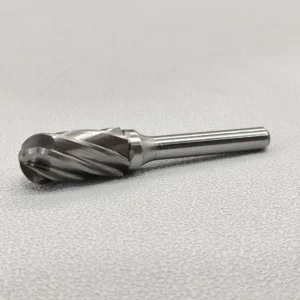Inhaltsverzeichnis
UmschaltenCarbide Grinding Burrs
Carbide grinding burrs are a critical tool in many industries, offering professionals an effective way to shape and polish various materials. However, before purchasing a carbide grinding burr, there are several important factors to consider. In this article, we will discuss what you should know about carbide grinding burrs, highlighting their benefits and application areas, while aiming to provide a comprehensive guide for potential buyers.
To begin with, let’s delve into the composition and structure of carbide grinding burrs. Carbide, a compound of carbon and metal, is known for its exceptional hardness and durability. These qualities make it an ideal material for grinding burrs, ensuring they remain sharp and efficient even when tackling tough materials.
One of the key benefits of carbide grinding burrs is their versatility. They can be used on a wide range of materials, including wood, metal, plastic, and even stone. This makes them invaluable in industries such as woodworking, metalworking, and automotive, where different materials need to be shaped and smoothed.
For instance, in woodworking, carbide grinding burrs are commonly used to shape and carve intricate designs in furniture or create detailed engravings. The precision and control offered by these burrs allow craftsmen to achieve stunning results with ease.
In the metalworking industry, carbide grinding burrs are highly sought after for their ability to remove excess material, such as weld beads or rough edges. This results in a smoother finish and enhances the overall quality of the product. Whether it’s in the fabrication of automotive parts or the construction of machinery, carbide grinding burrs play a crucial role in ensuring precision and efficiency.
Another important aspect to consider when purchasing carbide grinding burrs is the type of cut they offer. There are various shapes and designs available, each offering a unique cutting action. For instance, a flame-shaped burr is perfect for rough material removal, while a ball-shaped burr can be used for smoothing and blending surfaces. By selecting the right type of burr, professionals can optimize their workflow and achieve the desired results more efficiently.
Additionally, it’s crucial to pay attention to the shank size and compatibility with different tools. Carbide grinding burrs come in various sizes, and it’s important to ensure that they are compatible with the rotary tool or grinder being used. Investing in burrs with the correct shank size not only ensures a secure and stable fit but also enhances safety by minimizing the risk of accidents or excessive vibration.
Durability is another factor that sets carbide grinding burrs apart from other alternatives. Due to their exceptional hardness, they maintain their sharpness over a much longer period compared to traditional steel burrs. This not only translates to longer-lasting usage but also reduces the need for frequent replacements, ultimately saving both time and money.
Furthermore, carbide grinding burrs often feature tooth-like structures, known as flutes or cuts, which aid in chip removal. These flutes prevent clogging and allow for continuous cutting without interruptions. This is particularly beneficial when working with softer or gummy materials that tend to stick to the burrs.
Now, let’s turn our attention to the application areas that customers should consider when purchasing carbide grinding burrs. One crucial aspect is the desired finish or texture. Different burr shapes and cuts yield distinct results. For example, if a smooth and polished surface is required, a burr with fine cuts and a ball-shaped design would be suitable. On the other hand, a coarser finish may be desired in certain applications, such as removing excess material or creating a textured surface. In such cases, a burr with larger cuts or a flame-shaped design would be more appropriate.
Additionally, it’s important to consider the hardness and toughness of the material being worked on. Harder materials, such as steel or ceramic, require carbide grinding burrs with a higher level of hardness to ensure effective material removal. Conversely, softer materials, like wood or plastic, can be efficiently shaped and smoothed using burrs with lower hardness levels.
Moreover, the speed at which the carbide grinding burr operates plays a significant role in achieving desired results. Higher rotational speeds can result in greater cutting efficiency but may also generate more heat. Conversely, lower speeds generate less heat but may reduce the cutting performance. Therefore, it is essential to consider the optimal speed range recommended for specific burr models and adjust accordingly to maintain the balance between efficiency, quality, and safety.
In conclusion, carbide grinding burrs are indispensable tools for professionals across numerous industries. Their versatility, durability, and precise cutting action make them highly sought after in woodworking, metalworking, and other sectors. Considering factors such as the type of cut, shank size compatibility, desired finish, and material hardness is crucial when purchasing carbide grinding burrs. By understanding their benefits and application areas, professionals can select the right burrs for their specific requirements, enhancing their productivity, quality, and overall efficiency. So, whether you’re a seasoned craftsman or a DIY enthusiast, investing in carbide grinding burrs will undoubtedly elevate your projects to a whole new level of excellence.
